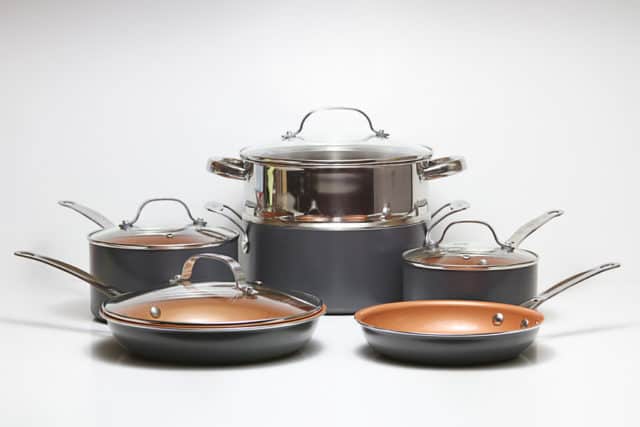Thinking about upgrading to a glass-ceramic induction cooktop?
One of the first things you’ll probably want to know is what kind of pots and pans are best for an induction cooktop. Is it necessary to buy all new pots and pans? How can you tell whether a high-quality induction cookware set is worth the extra cost?
Why induction cooktops are so popular
More home chefs are going for glass-ceramic induction cooktops because they heat quickly and with great precision. Plus, there’s no wasted heat. Unlike gas or electric cooktops, the thermal energy goes directly into the pot to cook the food instead of heating the area around your stove.
Induction cooktops are also easy to clean and safer to use. The coil in the induction cooktop transfers heat directly to the pan while the surface stays relatively cool.
A smooth glass-ceramic induction cooktop gives any kitchen a sleek look, too. Glass-ceramic also resists scratches and is strong enough to take impacts and temperature changes without cracking, warping or breaking.
Will my regular pots and pans work on an induction cooktop?
For pots and pans to be compatible with an induction cooktop they must be made of a magnetic material: either iron or iron-based, such as steel. Induction heating works by exciting the iron atoms in cookware, so there needs to be enough iron in your pots and pans for the heat to happen.
You can tell whether the pots and pans you’re currently using are magnetic simply by holding a magnet to the bottom of a pan to see if it sticks. You can also check the underside of your cookware for the induction logo.
But just because a pan is magnetic doesn’t mean it’s a good idea to use it for cooking on your new glass-ceramic induction cooktop. For example, some stainless-steel pans with too much nickel content react magnetically but may not work at all on an induction hob.
Basic tips:
- When shopping online for induction cookware, look for “induction ready cookware” or “induction cooktop cookware.”
- Use pans with a flat base that connects to the induction hob’s cooking zone. An uneven bottom can vibrate and make noise on the glass surface, and it won’t heat uniformly.
- The best lids for cooking on an induction cooktop are heavy enough to resist vibration when hot and to stay put if the food inside is bubbling hot.
- Match the size of the pan’s base to the induction cooking zone. Using a pan with a smaller bottom diameter than the hob creates a weaker magnetic field and less heat output.
- When shopping for the best cookware for induction, you may want to start by purchasing one pan for the smallest cooking zone. You can be sure its base fits the surface and test it before bringing home the whole set.
- Comfortable, sturdy, heat-resistant handles that stay cool during cooking are a must.
DO NOT use these pots and pans for induction cooktops
Cookware made only from glass (including Pyrex), aluminum or copper will not work on an induction hob. However, some cookware manufacturers offer aluminum or copper pans with a magnetized base that is specifically designed for induction cooktops.

Best kinds of pots and pans for induction hobs
Stainless steel
Stainless steel pots and pans are a great choice for cooking on an induction hob, but it’s important to shop for stainless steel cookware manufactured for induction cooktops. Here’s are some of the things to consider about stainless steel:
- Stainless steel pans with aluminum and copper cores placed in between the interior and exterior layers of steel conduct heat better than stainless steel alone. Be sure to purchase only high-end, superior quality copper and aluminum clad cookware – with low-quality pans you may hear a buzzing sound if the inside metal vibrates at a different speed from the outside with.
Pans with five-ply construction, or clad, maximize the even distribution of heat to all parts of the pan. (Copper pans are not compatible with induction cooktops.) - Pots and pans made with a layer of stainless steel and aluminum on the bottom, known as Tri-ply or clad, can be a smart choice. If the layers of steel and aluminum extend up the sides, the pan will conduct thermal energy more efficiently than if all the heat enters the bottom. It’s wise to go with the best quality pans you can afford here, too.
- Costs: The best stainless-steel pots and pans for induction cooking can be expensive. But high-quality performance and years of durability can save money in the long run.
Non-stick pans with a magnetized base
The interiors of these pans are heavy-gauge die-cast aluminum with a magnetized base for the rapid-heat transfer of an induction stove. Interior surfaces can be a non-stick coating derived from stone, hard-cost anodized, or other types of coatings. Look for pans that are cadmium and lead-free, and contain no APEO and PFOA, NMP and NEP (lesser used chemicals).
Cast iron
Thanks to their all-iron composition, cast iron pots and pans have the magnetic quality induction hobs needs. When “seasoned” properly, they are famous for their non-stick cooking capabilities. But is cast iron the best cookware for induction cooktops?
Cast iron isn’t ideal for cooking that requires fast temperature changes; it’s slow to heat and cool. Cast iron is also heavy.
Enameled porcelain cast iron pots and pans also work well with induction cooktops. They have non-stick surfaces and reliable heating, as long as the coating is evenly applied. Invest in premium quality enameled pots and pans and they will last a lifetime, with proper care.
Carbon steel is a lighter alternative to cast iron that heats up faster and is more responsive to temperature changes – good for cooking on an induction hob.
